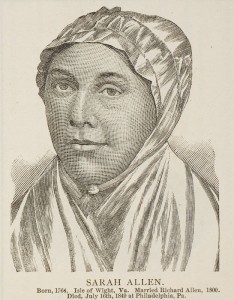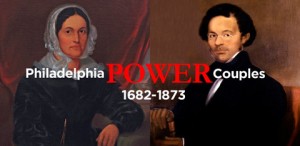 I attended the Philadelphia History Museum’s event for Women’s History Month. It hosted historian Dr. Cynthia Little who presented a Lecture entitled “Power Couples: 1682-1873.” She focused on the Women behind some of Philadelphia’s most prominent and important male figures. These women supported their husbands in ways that were critical to their husband’s success as major and great figures. Her point was that there was power, and impact in these women playing these roles that History should take note of and recognize.
I attended the Philadelphia History Museum’s event for Women’s History Month. It hosted historian Dr. Cynthia Little who presented a Lecture entitled “Power Couples: 1682-1873.” She focused on the Women behind some of Philadelphia’s most prominent and important male figures. These women supported their husbands in ways that were critical to their husband’s success as major and great figures. Her point was that there was power, and impact in these women playing these roles that History should take note of and recognize.
The lecture was not a presentation of a collection “Power Couple’s” if we follow the strict definition of the term. In my mind, and according to the Free dictionary, Power Couples can be defined, “as a couple both of whom have high-powered careers or are politically influential.” Most of the couples she presented would be more properly presented through the frame of one of a privileged assistant, super-secretary, advisor or consultant, to a boss. A power couple denotes, a certain level of equality, collaboration but a separation of identity, in which each person pursues their own interests.
Dr. Cynthia Little started her conversation with the Patriarch of this city, William Penn and his relationship with Hannah Callowhill. She goes on to include a collection of some of the most recognizable names in early American history, and to elaborate on why their mostly unsung and forgotten wives deserve a place in the discussion of their husbands accomplishments because they were so instrumental to their success. This would follow to be the theme and unspoken but identifiable argument of the lecture. By looking at the personal lives of these prominent men, she was able to provide a critical lense into their success that involves such an unconsidered group in the historical discipline. For this reason her talk was useful, informative and necessary.
My only reservation for this lecture are the possible truths that were revealed but were left unspoken in the marketing and storytelling aspect of this event and her talk. How do we reconcile the fact that I went to this program with expectations of learning about women who actually carved their own identities separate from their husband’s into history and instead I found women who were should be considered only through the name of their husbands? This is not exactly a negative thing. The importance that Little was obviously trying to show is that these women in of themselves were unique and special in a way that opened up these relationships to unique and gender-role transcendent possibilities.
In her examples she demonstrates how certain partners were able to form “Power Couples” through unique levels of trust between husband and wife and honest recognitions by the husbands of their wives talents and capabilities. These men entrusted uncommon levels and roles of responsibility that were normally left to the responsibility of men, to their wives. Throughout her lecture, her examples each demonstrated different levels of collaboration, and sharing of responsibilities that made some closer to what is normally defined as Power Couple, and others seem to hedge closer to the dynamic of an assistant and a Boss. Other examples turn the Gender roles completely on their heads, such as Betsy and John Ross. Little’s liberation of the definition of Power Couples is not some egregious falsehood or work of deception in order to draw in an audience, or sensationalize reality, but instead understandable and functional.
Little began her lecture with the Patriarch of this city William Penn who married Hannah Callowhill. William Penn was a man of brilliance but who was not good with money. Hannah was a daughter of a financial accountant and was trained in the practice of managing finances and advised him in financial decisions. Hannah Callowhill had strengths that were complementary to William and filled out his weaknesses. Is this a Power Couple? Maybe.
She also talked about George and Martha Washington, a couple that I found even more troubling to assign in the Power couple category. Martha Washington ran George’s plantation, and traveled thousands of miles to accompany George at Winter-camp every year to give him the emotional support that she saw as her duty. Outside of running his plantation, which although is a responsibility with much economic potential, it is not really outside the realm of the home and is not really outside of the traditional role of homemaking or the level of home business which women have historically been assigned, although considered her home is not the one found traditionally in the American home. I was not expecting to see examples of excellent companionship support systems, as the dynamic of a power couple.
The example of Franklin and his wife comes much closer to the definition of a Power Couple for several reasons. She would socialize in place of him at gatherings and conduct business for him, and also keep him up to date and aware of the situation in the state while he was overseas. She was able to speak in his place, and stand in his place and in this way was able to assert her identity and will in the public community on an influential and impactful level and put her own touch on the society and prodigious circles. Maybe a more contextual look at what a Power Couple would mean relative to its time period would allow, us to be fairer in disagreeing with the definitions of the term. Maybe the term can expand and shrink relative to the amount of opportunity women have at the time. But on the other side of the coin there were couples that, at the same time were demonstrating the conditions of what I would call a Power Couple.
The only couple that fit the strict definition of Power Couple who she presented was Sarah and Richard Allen. Richard and Sarah were both working towards their own independent goals. They both did their own unique individual jobs, instead of just one working for the other they were both raising money to build their church, instead of Sarah strictly handling Richard’s finances. Sarah also had her own operations she conducted that were hers to claim, such as her charity the Women’s Missionary Society and she was known throughout region as a prominent figure of power. I wonder if the fact that they were already outside the status quo of the society, being an African American couple allowed them to feel more comfortably switching up the normative gender.
In a constant battle of trying to tell a full and all-encompassing history we are determined in our search for different, and open-minded angles that present the impacts and stories of history’s unmentioned groups and individuals. Cynthia Little was successful in this difficult task, but at the same time she represented the challenges in this demanding effort; which are to convince the audience, public and academia that these stories and people are worth being studied and looked into. The title and term usage of Power Couples is the visible strain of carrying out this versatile effort. The History of Women no matter how significant, and of serious importance you claim it to be will in so many ways simply not carry the aura of what general audiences will consider real history, in which one can see visible cause and effect on influential political and social levels where their decisions and emotions directly translate into law and the status quo. By saying that these women formed Power Couples we see Little trying to appeal to the general audiences’ normal conceptions of who we should talk about in history- the people who are actually carving their own individual and distinct marks in history. In a certain way Little’s use of the term is both fitting with this conception and misleading, because these women are impacting history but only through their relationships with a man who ultimately surrogates the final actions and decisions that cause the effects that create and change history.

